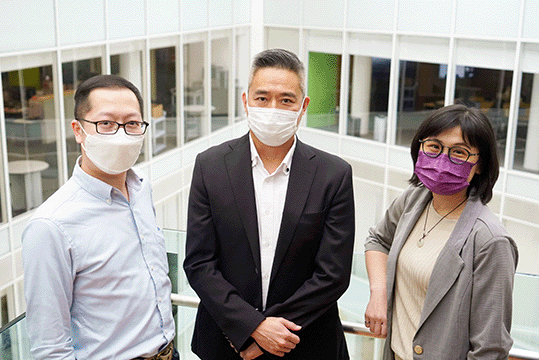2022.06.27
Now, new, next - research and disruption pave the way to future

Without a crystal ball to predict what’s next in our turbulent world, some resort to focusing on “Now, New, Next” methodologically via research and development with breadth and depth. Board member of the Construction Innovation and Technology Application Centre (CITAC) Ir Dr Ricky TSUI, who is also Arup’s Director of R&D, is a firm believer of foresight and research.
Now – “Total design” concept copes with various circumstances
Every project is unique. The needs and constraints vary in different stages and nature of projects. Expertise and due considerations from various disciplines and professions are essential to quality delivery under different circumstances.
“In Arup we adopt a ‘total design’ philosophy, which encourages collaborations across different disciplines from urban planning, architecture, construction engineering, building management to data science and artificial intelligence. Our 58 skillsets in the firm under the umbrellas of fundamental engineering, digital, sustainable development and advisory intertwines with projects as appropriate,” Ricky explained.
Anita Siu, Associate Director and Samuel Tang, Assistant Manager-Research from Ricky’s team oversee the “future” and “present” of the 58 skillsets in terms of their application and steer in the firm’s multi-pronged projects, integrating the most suitable and advanced technology into its own practice and advisory.
New - Common data environment enables cross-disciplinary collaborations
Digital advancement has enabled a more thorough and in-depth integration and collaboration of different disciplines. A common data environment throughout the entire project life cycle from design, construction, testing and commissioning, through to operation and maintenance is highly sought after for its efficiency and sustainability.
“Often we see different parties in the value chain build their own building information models (BIM), which are not transferrable or integrated with others in the chain, resulting in multiple and incoherent systems in one single project. Holistic planning and management of the project from design to operation stages are not possible,” said Ricky. “With a common data environment, all relevant design decisions need to be considered together and integrated into a whole by a well-organised team. As a multidisciplinary consultant, it is making our ‘total design’ vision more achievable than ever.”
While BIM has been widely adopted during design and construction stage, Arup foresees its potential integration with other systems. A team of Arup engineers developed Neuron, a state-of-the-art digital platform that serves as the ‘brain’ of a building for smart operation. Leveraging on the latest digital technologies in BIM, IoT, AI and VR supported by Arup’s domain knowledge, Neuron integrates data generated from different systems to maximise building operation efficiency, minimise energy consumption, reduce carbon emission, promote user wellness and healthy environment. “We want to create a game changing digital twin platform to redefine future building operation. We believe it has a huge market with growing demands that will be getting more and more sophisticated with time,” said Ricky.
“Three or four years ago we started using this platform for several proof-of-concept client projects. As it matures and evolves, we are able to commercialise it for broader use, offering software as a service (SaaS), expanding to reach the end users who manage and utilise the asset.”
Neuron is currently in display in the CITAC Exhibition. Feel free to drop by and visit at the Zero Carbon Building.
Next - Disruptive changes benefit community
Discovering what is new at the point of time now will probably shed light on what next will be.
“Tens of years ago we were talking about building taller buildings, bridges, transit-oriented developments and the like. Now we are focusing on topics such as ‘smart, green, resilience’, digital transformation and wellness.”
Technological innovation changes the world faster than one could imagine. “We in R&D used to work with universities. Recently, we also collaborate with start-ups to enhance our quality and efficiency of work. For example, we engage some artificial intelligence firms while we provide the engineering expertise, creating new ‘cross-over disciplines’,” Ricky explained. “We are happy to incubate more new skills – by no means there is an upper limit for the current 58 skillsets.”
The firm also actively works with developers for innovative projects, such as CAPS - the outdoor air purification system for bus stop, now in place at Cyberport, the bladeless Air Induction Units (AIU) in the public transport interchange at Yue Man Square, Kwun Tong. “We see a lot of potential in these projects as they bring positive impacts to society and are eager to progress further.”
CITF invests in innovative construction methods
Similar to the Construction Innovation and Technology Fund (CITF) which is implemented by the Construction Industry Council (CIC) to encourage wider adoption of innovative construction methods, Arup allocates a certain percentage of its revenue as research funding, which is granted in accordance with the firm’s innovation roadmap updated regularly. Four development areas, namely, cities, digital, emerging technologies and circular economy are highlighted in the firm’s latest research agenda.
In fact, Arup itself has applied for the CITF for its laser scanning technology, which is utilised to produce 3D scanned virtual environment for design and inspection works. “As an international firm, we enjoy the advantage of grasping cut-edge technologies across the globe and are able to introduce those matured back to Hong Kong,” said Ricky.
Other than fundings, the firm values the need of talent incubation. It has collaborated with local and mainland universities on topics such as the future of railway stations and impact of night-time lighting in town.
“Ideas from students who are from less relevant faculties such as psychology and sociology could also be insightful, as users’ experience is gaining traction in project design and delivery,” Anita and Samuel concluded.
